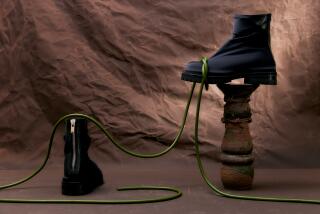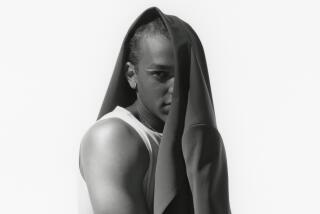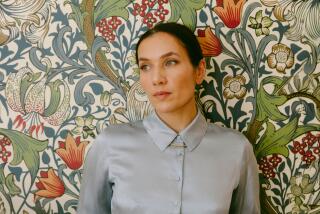Comfort Is in the Eye--and Zone--of the Wearer
- Share via
Remember the last time you saw a woman whose style you envied? Didn’t she look sexy, stunning, sharp, comfortable? Bzzzzz. Wrong answer. A well-dressed woman may catch your eye, but probably not because she looks blissfully comfy.
Describing a style as “comfortable” is the fashion equivalent of telling an eligible male chum that his blind date has “such a pretty face.” He hears those words as girl language for “she could lose about 50 pounds.” Similarly, an outfit that looks comfortable is seldom thought of as glamorous, pretty or hip, qualities many women who care about how they dress would like to achieve. Comfort is a romance past its first heat, not passion in the ascendant.
Women raised to believe that being born female requires suffering for beauty will routinely submit to eyebrow tweezing, leg waxing and other ouch-provoking treatments. But insist they wear a scratchy sweater and you’ve got a revolution on your hands.
It isn’t that their pain quota is used up by their beauty rituals, or that their vanity doesn’t extend to their closets. Women who work outside the home and families and busy lives (in other words, everyone you know) simply don’t have time to be uncomfortable in their clothes. They can’t always run to the restroom at work to tuck in a slippery shirt before a meeting or stop to change their shoes before walking the dog at the end of a long day at the office.
When they have clothes that work, that don’t constrict their breathing or distract their thinking, they can go about doing what they were put on Earth to do, whether that’s baking cookies, writing screenplays or building bridges.
Designer Michael Kors stays in touch with his customers and heeds the feedback they give him. “The key ingredient in fashion in the ‘90s is comfort,” he says. “In a lot of other decades, women were ready to jump into whatever look came along, regardless of the comfort factor. Now, if a woman tries something on in a store and it doesn’t feel right, it goes right back on the rack. This is true across the country, in every age group, at every price level.”
So if we want comfortable clothes, then the challenge lies in finding appealing things to wear that aren’t frumpy. Sweats are both wearer-friendly and low on the style scale. Ditto for the uniform of leggings and oversized tops adopted by too many women who value comfort.
Although there is an answer to the comfort-plus-style-equals-nirvana equation, there is no single solution. One woman’s comfort is another’s torture. Even all-American jeans aren’t universally popular. “Too heavy, too tight, too rough,” says a woman who doesn’t own a pair. “That big, fat seam in the crotch always chafes.”
It’s easier to define what isn’t comfortable than what is. A random sampling of women turned up a hate list of everything from jeans to pantyhose, bras and shirts. Everyone bad-mouths things that bind, itch, scratch, slip, gap or strangle.
We found that women who would have a hard time deciding which would be the worse nightmare--having to wear clothes that were uncomfortable or clothes that didn’t look good--were fountains of practical wisdom. When it comes to their wardrobes, they want it all, and awareness of the following tips helps them get it.
* Find the right underwear and hosiery. Not surprisingly, the foundation of a comfortable wardrobe is often a matter of starting with the right foundations. Women complain about bras that hurt or don’t stay in place, panties that pinch and ride up. The anti-pantyhose contingent, which maintains that the only good hosiery is none, is particularly vocal in this climate, where mild temperatures let us get away with going barelegged much of the year.
It takes experimentation to yield undergarments that work, but with innovative stretch fibers making flexible body fashions increasingly smooth, soft and light, the range of desirable lingerie alternatives expands. The trouble is, most women would rather devote their shopping excursions to garments seen outside their bedrooms. But quality time spent in that dreaded, fluorescent-lit department store fitting room is worth it. Once you’ve licked the underwear problem, everything else gets easier.
* Be a minimalist. Accessories can be the worst offenders of comfort. Fortunately, fashion is on your side on this one, because earrings that mutilate your tender lobes, heavy necklaces and bracelets that bruise, belts that are too tight and scarves that annoy have been less the look lately than simple, unadorned styles championed by such spare designers as Giorgio Armani, Calvin Klein and Jil Sander. When a new accessory does become popular, be skeptical. How many hip belts stay where they’re supposed to? “Anything that needs to be readjusted is insane,” says Kors. It can take a little practice to feel “finished” without a load of accessories, but gradually, your eye will adjust to a less complex look.
* Don’t overload. Pile a tank top under a shirt under a vest under a jacket under a coat and you can wind up feeling like a bundled-up child so stuffed into a snowsuit she can barely walk. If you’ve never worn dresses, you don’t know how easy and comfortable one piece--on its own--can be.
“If we show a long-sleeved shirt with a skirt or trousers, it would probably be about just the shirt, without another layer,” Kors says. “Too many sleeves are uncomfortable. If you have a jacket on, why on earth do you want two sets of sleeves on your arm? A shirt twisting and moving around under a jacket can drive you crazy. We show jackets with knit tops or T-shirts, and often those are sleeveless.”
* Become a fabric expert. The fashion industry’s hunger for the next great thing has led it straight into comfort country, where a variety of knits and clothes made of stretch fabrics are favorites. “For most of my customers, exercise clothes and active sportswear rocked their world,” Kors says. “They’ve found out how great clothes with Lycra and stretch supplex feel, and they want to avoid putting on armor for work or going out to dinner.” Although some of the styles in Kors’ spring collection are as sleek and clingy as a leotard, the new fabric technology can also be a less obvious asset.
“It’s the biggest misconception to hear the word “stretch” or “Lycra” and think that it only means something skintight that you have to be a size 2 or 20 years old to wear,” says the designer. “I’ve had suits made for myself out of a stretch gabardine and I’m a normal guy with a normal body.” Materials blended with stretch fibers give, move with the body and retain their shape. Pants don’t bag at the seat or knees, armholes accommodate your reach and even slim, shaped jackets feel roomy enough for a claustrophobe.
* Know thyself. How comfortable we are in our clothes is often more psychological than physical. A perfectionist could choose to squeeze into girdle-at-the-top pantyhose rather than endure the psychic discomfort of having a protruding belly on display. Some women are uncomfortable in sweats. “I’m always afraid I’ll eat too much when I wear something with an elastic waist,” says one. “I lose my sense of my body in clothes that are too roomy and I just feel terrible.”
How much attention do you like? Is a day without a compliment a day without sunshine? A woman who expects and invites her clothes and figure to be noticed will be uncomfortable when no one reacts. So as comfortable as she might physically be, if she hasn’t dressed to feed her inner show-off, she won’t feel good.
Consciously or unconsciously, we all plan our attack, so to speak. When we choose a bright color, we’re inviting more attention than when we wear predictable black. You’ll be uncomfortable in a color that makes you feel conspicuous on a day when your mood is withdrawn. It’s important to get in touch with your level of exhibitionism. No matter how stylish a very short skirt, or how dreamy a sheer nightgown of a dress is, a woman who is self-conscious about her legs or who is modest will never be happy wearing them. Dressing in conflict with your self-image sabotages comfort. If you see yourself as Kathie Lee Gifford perky, you won’t feel right in dark duds that could have come from Courtney Love’s hole of a closet.
Real style involves an understanding of appropriateness. The socialite who volunteers at a shelter in a designer suit shows a lack of sensitivity that makes her unstylish. The considerate woman pays attention to the comfort of others, like the Westwood travel agent who wears flats in order not to be taller than her husband.
A memorable invitation to a fund-raising dinner for the Dalai Lama at the Beverly Wilshire Hotel read, “His holiness enjoys bright colors, but is uncomfortable with too much skin.” The Tibetan spiritual leader isn’t the only one. It’s bad manners, if not downright dumb, to ignore how uncomfortable your most revealing clothes can make your boss, your date, your friend’s father sitting across the dinner table.
* Interpret fashion trends. Funny how women who wouldn’t think of rushing to see each movie that opens believe they’re supposed to love every new look fashion serves up. No matter how hot 5-inch heels are, any woman who tells you she’s comfortable walking in them all day is lying. Have the confidence to pass up styles that cause you agony.
That doesn’t mean you shouldn’t pay attention to what’s new, or keep an open mind. The more you know about the construction of clothes, the more you can spot the comfortable ones. “The way clothes are made today changes the way they feel on the body,” Kors says. “Double-faced clothes have no lining, no facing, no bulk, no weight. You look polished and tailored without horsehair andinterlinings, the things that make clothes heavy, uncomfortable and old-fashioned.”
If you study the lines of the latest styles, you are more likely to come up with comfortable combinations. For example, if you love loose clothes, find ways to balance the bagginess. Big, faded denim overalls with a snug, stretchy shirt is the favorite outfit of a psychotherapist who see clients in her Pacific Palisades home office. “If I wore a full top, I’d look like a clown, but the contrast of tight and loose and shiny and dull fabrics really works,” she says.
Don’t be intimidated by certain categories of clothes. A jersey dress meant for black tie occasions can be more comfortable than a suit, depending on the fabric and fit. A personal trainer swears a black lace bustier she wears out dancing with velvet cigarette pants is one of the most comfortable things in her closet. “It has so much stretch in it that it stays in place, doesn’t expose too much cleavage, and never feels tight,” she says.
* Don’t ignore Mother Nature. It isn’t feminist paranoia to state that the world is designed for men who wear jackets. “Offices, restaurants, hotels, airplanes are always too cold,” a newspaper reporter who travels a lot complains. “Then I look around and see I’m wearing a short-sleeved dress and the men are wearing shirts and jackets. No wonder I’m freezing.”
It’s hell to be too hot or too cold. Even if the weather reporter is occasionally wrong, pay attention to the forecast and dress accordingly. You can’t possibly be comfortable in a mohair sweater on a warm day. Many fabrics, like rayon, jersey, silk, even cotton and wool, are seasonless. You can adapt them by planning ahead for rooms that are overheated in winter and arctically air-conditioned in summer by bringing along a layer that can be added or subtracted as the temperature changes.
A friend of ours resolved, after her June milestone birthday, to adapt to fashion trends more quickly and to make more of an effort to spiff up for work and play. She abandoned her favorite outfit, a small man’s cashmere cardigan and stretch velour jeans and, aided and abetted by July sales and fall clothes stocked in stores in August, she bought new high heels, a would-be trousseau of push-up bras, tight leather pants and shrunken tops. By Columbus Day, she was back in her sweater and soft slacks. “Life’s too short,” she said, looking better than she had in weeks.
Ultimately, comfortable clothes are sexy. In “Pretty Woman,” Richard Gere told Julia Roberts, “Stop fidgeting.” How much more beautiful she was when she didn’t fuss with her clothes.






